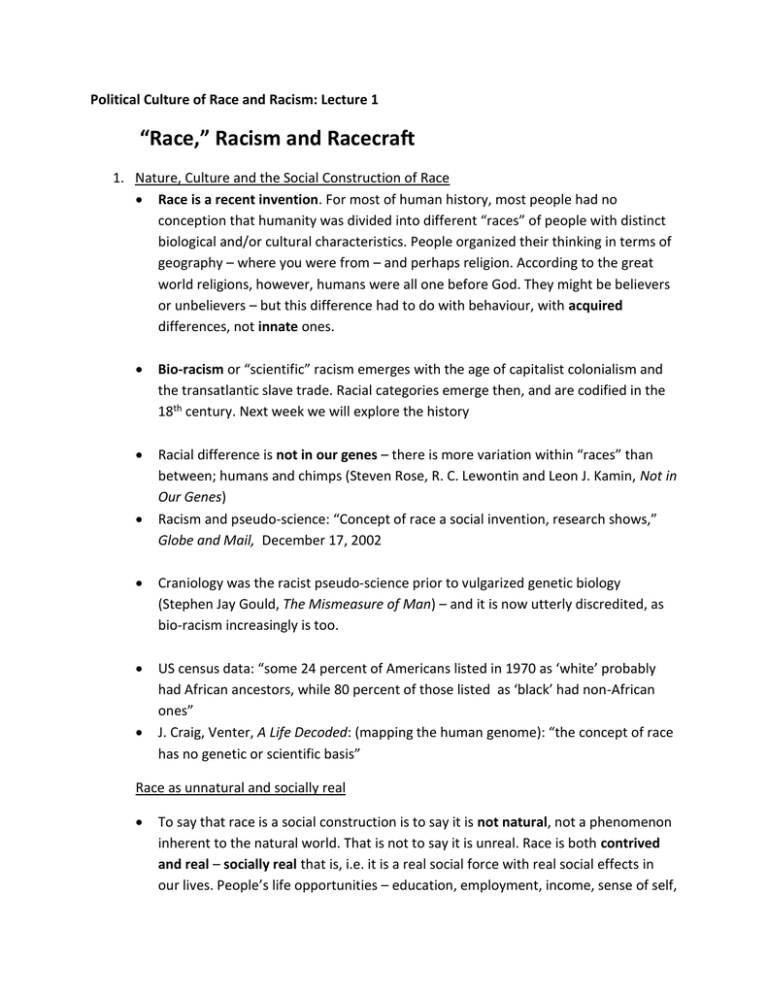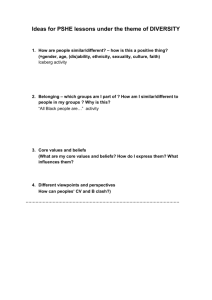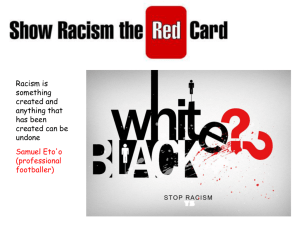Lecture-1-Summary-POLS-3065
advertisement

Political Culture of Race and Racism: Lecture 1 “Race,” Racism and Racecraft 1. Nature, Culture and the Social Construction of Race Race is a recent invention. For most of human history, most people had no conception that humanity was divided into different “races” of people with distinct biological and/or cultural characteristics. People organized their thinking in terms of geography – where you were from – and perhaps religion. According to the great world religions, however, humans were all one before God. They might be believers or unbelievers – but this difference had to do with behaviour, with acquired differences, not innate ones. Bio-racism or “scientific” racism emerges with the age of capitalist colonialism and the transatlantic slave trade. Racial categories emerge then, and are codified in the 18th century. Next week we will explore the history Racial difference is not in our genes – there is more variation within “races” than between; humans and chimps (Steven Rose, R. C. Lewontin and Leon J. Kamin, Not in Our Genes) Racism and pseudo-science: “Concept of race a social invention, research shows,” Globe and Mail, December 17, 2002 Craniology was the racist pseudo-science prior to vulgarized genetic biology (Stephen Jay Gould, The Mismeasure of Man) – and it is now utterly discredited, as bio-racism increasingly is too. US census data: “some 24 percent of Americans listed in 1970 as ‘white’ probably had African ancestors, while 80 percent of those listed as ‘black’ had non-African ones” J. Craig, Venter, A Life Decoded: (mapping the human genome): “the concept of race has no genetic or scientific basis” Race as unnatural and socially real To say that race is a social construction is to say it is not natural, not a phenomenon inherent to the natural world. That is not to say it is unreal. Race is both contrived and real – socially real that is, i.e. it is a real social force with real social effects in our lives. People’s life opportunities – education, employment, income, sense of self, life expectancy, etc. – are profoundly determined by the social relations of race. But race is not part of the natural structure of the world in which we live. Ideology naturalizes social relations – as with, say, gender and sexuality. And class. But because it is socially real, race has extensive social usage: government agencies, social service organizations, NGOs all use its terminology. Consider employment equity programs. And most of us use this terminology – and its conceptual apparatus – in everyday conversation. This is race as a folk concept. But folk concepts are part of everyday social-cultural practices, and have real effects. In 1940, the American Red Cross ordered segregation of the US blood supply for what it called “reasons not biologically convincing” but “commonly recognized as psychologically important in America.” The instability of “race” Because race is a social construction, it is highly flexible, e.g. the Irish as non-white – slides There can be other versions of “race” – culture, or even “meta-racism” or “neoracism.” And these have points of convergence with class racism, as we shall see. But in each version there is no real entity called “race” there – be it biological or cultural – that has any objective existence outside the orderings of a human society. In all its forms, race is a social construction and a social relation. 2. Understanding Racism “Racism is first and foremost a social practice. . . Racism always takes for granted the objective reality of race . . .” Practices are conscious, filled with sentiments, anxieties, beliefs, common sense and good sense Dominant ideas and ideology Some of this becomes unconscious, even if it is in part articulated – usually in distorted form Racism can have explicit and aggressively violent forms – Slavery, Jim Crow, Nazism and anti-semitism. Political parties today: Golden Dawn (Greece), National Front (France), British National Party. But it can also have much more subtle, everyday forms. Race becomes both seen and unseen – part of the social background that forms the horizon of daily life. It becomes part of the way we describe the world and act on it even when we are not being aggressively racist: censuses, criminal reports. We don’t see that we are constructing race because we see it as already there – reification: turning a social activity into a thing. “Race” is both unstable and highly adaptable. Today bio-racism has largely given way to cultural racism. 3. Racecraft “Race is the witchcraft of our time” – Ashley Montagu A system of beliefs and practices that makes highly dubious claims seem plausible. Hence, a craft, because it is an artifice, a human creation, a social construction. Consider this statement: “Black Southerners were targeted because of their skin color.” This invokes what the Fields call a “weird causality” in which an effect of racism – the stigmatization of a skin color – is made the cause of racist targeting This is why we insist on the need to see race as a social relation – a way of being and acting. Something that actually happens between people. Class and gender are also social relations, as is heterosexuality (and heterosexism). These are also relations of domination. Not just unpleasant ideas, but oppressive social practices of a systemic nature. 4. Systemic Racism More than a set of beliefs It is a systemic set of social practices, attitudes, beliefs, and behaviours that push large numbers of people of a specific social group into a subordinate position. This is why it does not make sense to speak of anti-white racism (even if there is such prejudice). Here I differ with ‘Race’ and Ethnicity in Canada, pp. 187-89. They confuse prejudice and violence with the social relations of domination that are racism.




